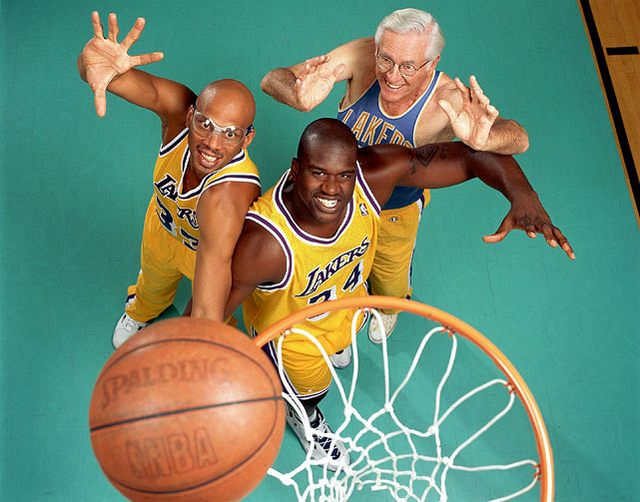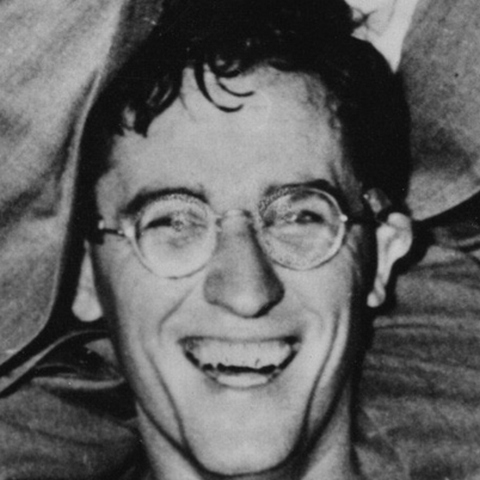
Sponsored Ads
|
» Home
» Sports » George Mikan gentle giant and the first big dominant basketball player in the history of NBA has Croatian roots
» Home
» People » George Mikan gentle giant and the first big dominant basketball player in the history of NBA has Croatian roots
» Home
» Education » George Mikan gentle giant and the first big dominant basketball player in the history of NBA has Croatian roots
» Home
» Croatian Life Stories » George Mikan gentle giant and the first big dominant basketball player in the history of NBA has Croatian roots
| George Mikan gentle giant and the first big dominant basketball player in the history of NBA has Croatian roots |
| By Darko ®ubrinić |
Published
07/20/2013
|
Sports , People , Education , Croatian Life Stories
|
Unrated
|
|
|
|
GEO. MIKAN VS KNICKS in Maddison Square Garden, part 2
George Mikan, 212 cm tall
 Three giants in the history of the NBA: George Mikan, Shaquil O'Neal and Kareem Abdul-Jabbar
GEORGE MIKAN
In the game of basketball, before there was Michael Jordan, Larry Bird, or Magic Johnson, there was George Mikan. Known as the first NBA superstar, George Mikan dominated the game throughout his entire career. As a center for the Minneapolis Lakers in the 1940's and 50's, George Mikan led his team to six professional basketball titles in seven years and a place in NBA history as the NBA!s first dynasty team.
Born on June 18, 1924 in depression-era Joliet, Illinois, George (along with his two brothers Joe and Ed and sister Marie) worked as a child in Mikan’s Tavern, his grandparents' restaurant situated near the industrial part of town. "My hardworking parents were named Joseph and Minnie", Mikan says. Mikan's grandparents had immigrated to the United States in the early 1900's from Vivodina, Croatia. George Mikan's grandfather Juraj, after whom he is named George, originally left Croatia alone to earn enough money to bring over his wife Marija. He settled in Pittsburgh and went to work in the steelmills. Within three weeks he made enough money to send for Marija. Shortly thereafter, the Mikan family moved to Illinois where the grandfather eventually bought their combination tavern and restaurant at the comer of Elsie Avenue and North Broadway in Joliet. "Gramps and Dad took care of the tavern business and tended bar until the three of us boys were old enough to see over the bar" remembers Mikan. "Mom was the restaurant cook. Her 35-cent fried chicken became a staple of the community. We kids did everything else at Mikan's Tavern from waiting on tables to cleaning fish for our weekly Friday night fish dinners."
When he grew to six feet tall at age 11, George began to get involved in basketball. Remembering his grandmother at that time, Mikan states, "Although Grandma didn't know the rules of basketball, she knew when something wasn!t right. She decided all the court squabbles with the end of her broomstick." Mikan attended seven years of grammar school at St. Mary's Croatian School in Joliet. At age 12, Mikan went on to Joliet Catholic High School but soon transferred to Quigley Prep Seminary School after being cut from the Joliet basketball team because of his poor vision. "Quigley was a training ground for future priests on the north side of Chicago located 50 miles from my home" Mikan explains.,"I was able to transfer there thanks to my mom and Fr. Violich, the parish priest at St. Mary's Croatian School. Father Violich thought I would make a good priest, and my mother and grandmother agreed." At Quigley Seminary, Mikan studied for the priesthood, but his height, six and a half feet at the age of 16, drew him deeper into the basketball program at which he excelled. After graduating from Quigley, George accepted a scholarship offer and committed to De Paul University where he played under coaching great Ray Meyer.
While at De Paul, Mikan (then six feet, ten inches) led his team to an 81-17 record and won the NIT Championship in 1944. Individually, Mikan was All-American First Team, Player of the Year, NIT All Star, and NIT Most Valuable Player. After graduating from De Paul, Mikan married his sweetheart Patricia, obtained his law degree, and began playing professional basketball for the Chicago American Gears of the National Basketball League. When the league folded, Mikan signed with the Minneapolis Lakers. At this point, his career really took off. With the Lakers, Mikan won six NBA championships, was a five time NBA All Star, led the league in scoring for five consecutive years, was voted Mr. Basketball of the First Half of the Century, and was enshrined into the NBA Hall of Fame.
After retiring from basketball in 1956, George Mikan was involved in a number of business ventures. He quickly turned his eye to politics and ran for Congress in 1956. At age 31, Mikan was new to the political arena but he displayed the same determination and hard work that he displayed on the basketball court. Mikan easily won the Republican nomination and gave the 15-year incumbent Democrat a run for his money. When all the votes were counted, George had lost by half of I percentage point, one of the closest races in the history of Minnesota. Eventually George started a successful travel agency. This success allowed him to return to basketball as the first Commissioner of the American Basketball Association (ABA), and he worked in the front office of the Minnesota Timberwolves. Today, at age 75 [that is, in 2000; D.®.], George and his wife Pat relax in Minnesota, where they have lived with their six children since George's first years with the Lakers.
Adam Eterovich Bracanin
|  GEO. MIKAN VS KNICKS in Maddison Square Garden. George Mikan on the ladders.
George Mikan 1924-2005
Mikan was so dominant that he caused several rule changes in the NBA, among them widening the foul lane—known as the "Mikan Rule" — and introducing the shot clock.
George Mikan was born in Joliet, Illinois, as an American of Croatian descent. As a boy, he shattered his knee so badly that he was kept in bed for a year and a half. In 1938, Mikan attended the Chicago Archbishop Quigley When Mikan entered Chicago's DePaul University in 1942, he stood 6' 10", weighed 245 pounds, moved awkwardly because of his frame, and wore thick glasses for his near-sightedness.
However, Mikan met 28-year-old rookie DePaul basketball coach Ray Meyer, who saw potential in the bright and intelligent, but also clumsy and shy freshman. Put into perspective, Meyer's thoughts were revolutionary, because at the time it was believed that tall players were too awkward to ever play basketball well. In the following months, Meyer transformed Mikan into a confident, aggressive player who took pride in his height rather than being ashamed of it. Meyer and Mikan worked out intensively, and Mikan learned how to make hook shots accurately with either hand. This routine would become later known as the Mikan Drill. In addition, Meyer made Mikan punch a speed bag, take dancing lessons and jump rope to make him a complete athlete.
From his first National Collegiate Athletic Association (NCAA) college games for DePaul on, Mikan dominated his peers. He intimidated opponents with his size and strength, was unstoppable on offense with his hook shot, and soon established a reputation as one of the hardest and grittiest players in the league, often playing through injury and punishing opposing centers with hard fouls. In addition, Mikan also surprised the basketball world by his unique ability of goaltending, i.e. jumping so high that he swatted the ball away before it could pass the hoop. In today's basketball, touching the ball after it reaches its apogee is forbidden, but in Mikan's time it was legal because people thought it was impossible anyone could reach that high. "We would set up a zone defense that had four men around the key and I guarded the basket," Mikan later recalled his DePaul days. "When the other team took a shot, I'd just go up and tap it out." As a consequence, the NCAA and later the NBA outlawed goaltending.
Mikan was named the Helms NCAA College Player of the Year twice in 1944 and 1945 and an All-American three times, leading DePaul to the NIT title in 1945, which was the same as an NCAA championship back in 1945. Mikan led the nation in scoring with 23.9 points per game in 1944–45 and 23.1 in 1945–46. When DePaul won the 1945 National Invitation Tournament, Mikan was named Most Valuable Player for scoring 120 points in three games, including 53 points in a 97–53 win over Rhode Island, equalling the score of the entire Rhode Island team.
Mikan is lauded as the pioneer of Modern Age basketball. He was the original center, who scored 11,764 points, an average of 22.6 per game, retired as the all-time leading scorer and averaged 13.4 rebounds and 2.8 assists in 520 NBL, BAA and NBA games. As a testament to his fierce playing style, he also led the league three times in personal fouls.[2][5] He won seven NBL, BAA, and NBA championships, an All-Star MVP trophy, and three scoring titles, and was a member of the first four NBA All-Star games and the first six All-BAA and All-NBA Teams. As well as being declared the greatest player of the first half of the century by The Associated Press, Mikan was on the Helms Athletic Foundation all-time All-American team, chosen in a 1952 poll, was inducted into the Basketball Hall of Fame in 1959, made the 25th and 35th NBA Anniversary Teams of 1970 and 1980 and was elected one of the NBA 50 Greatest Players in 1996.[1][2][5] Mikan's impact on the game is also reflected in the Mikan Drill, today a staple exercise of "big men" in basketball.
When superstar center Shaquille O'Neal became a member of the Los Angeles Lakers, Sports Illustrated graced its November 1996 issue with Mikan, O'Neal and fellow Lakers legend Kareem Abdul-Jabbar, calling Abdul-Jabbar and Mikan the "Lakers legends" to whom O'Neal was compared. Since April 2001, a statue of Mikan shooting his trademark hook shot graces the entrance of the Minnesota Timberwolves' Target Center.[2] In addition, a banner in the Staples Center commemorates Mikan and his fellow Minneapolis Lakers. He is also honored by a statue and an appearance on a mural in his hometown of Joliet, Illinois.
Mikan became so dominant that the NBA had to change its rules of play in order to reduce his influence such as widening the lane from six to twelve feet ("The Mikan Rule"). He also played a role in the introduction of the shot clock, and in the NCAA his dominating play around the basket led to the outlawing of defensive goaltending. Mikan was a harbinger of the NBA's future, which would be dominated by tall, powerful players.
As an official, Mikan is also directly responsible for the ABA three-point line, which was later adopted by the NBA, the multi-colored ABA ball, which still lives on as the "money ball" in the NBA All-Star Three Point Shootout, and the existence of the Minnesota Timberwolves.
In 1947, he married his girlfriend Patricia, who remained his wife the next 58 years until he died. Mikan fathered six children, sons Larry (George Lawrence Mikan III), Terry, Patrick and Michael and daughters Trisha and Maureen. All his life, Mikan was universally seen as the prototypical "gentle giant", tough and relentless on the court, but friendly and amicable in private life. He was also the older brother of Ed Mikan, another basketball player for both DePaul and the BAA.
Shaquille O'Neal offered to pay for Mikan's funeral. He said: "Without number 99 [Mikan], there is no me." Before Game 5 of the 2005 Eastern Conference Finals between the Heat and the Detroit Pistons, there was a moment of silence to honor Mikan. Bob Cousy remarked that Mikan figuratively carried the NBA in the early days and single-handedly made the league credible and popular.
Source georgemikan.com
|   George Mikan in front of the monument of George Mikan.
Discussing with George Mikan (212 cm) on equal foot.  Please, go to the next page below.
|
|
|
Comments
-
Comment #1
(Posted by Tomislav)
This is the best article about George Mikan until today.
Thanks Darko, you are a genius
Submit Comment
|
|